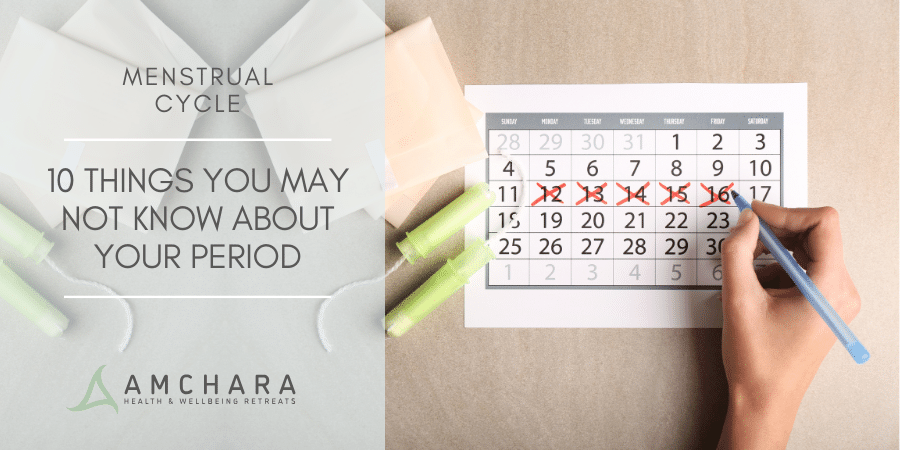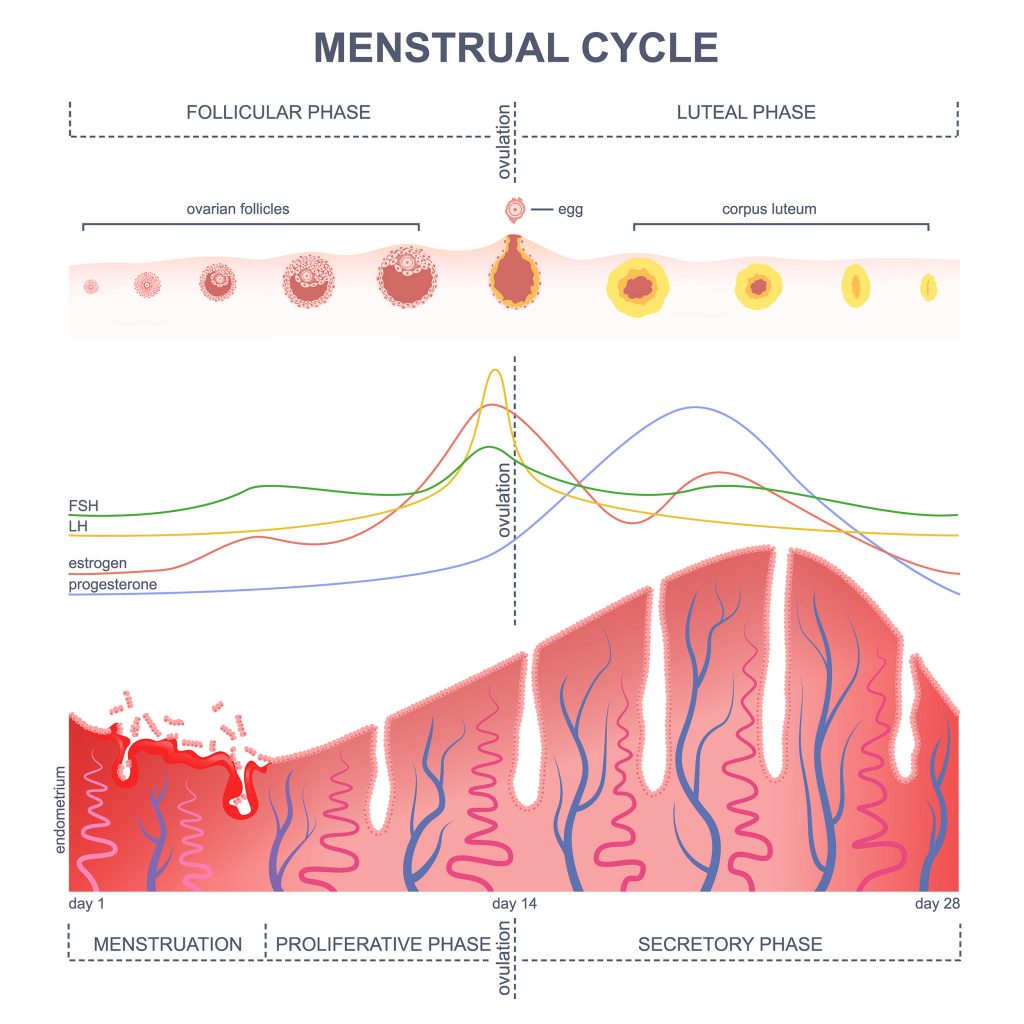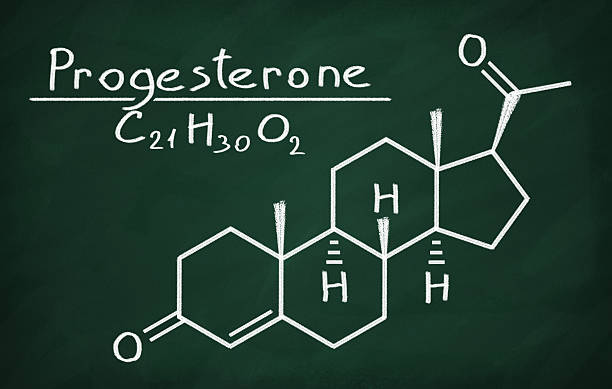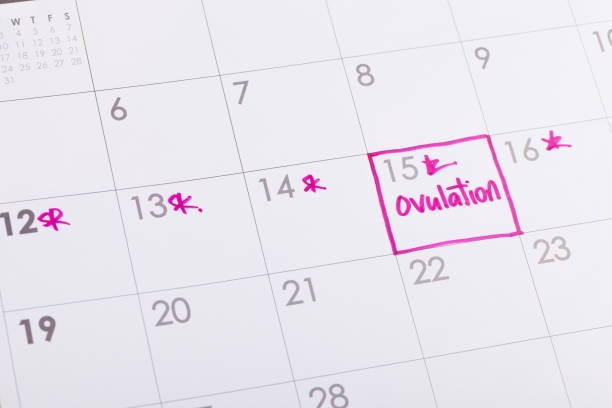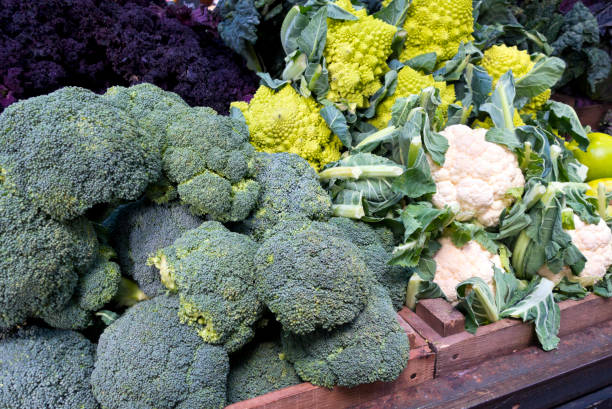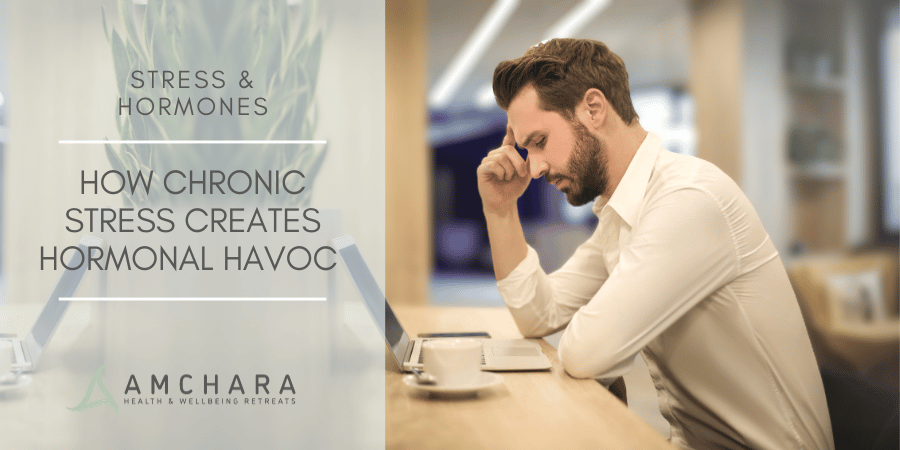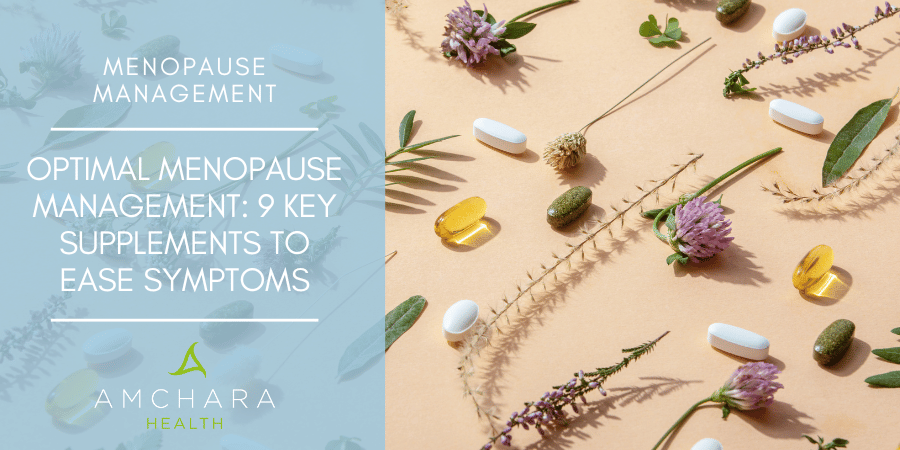2 Minute Video | Heavy Periods | Irregular Periods | Painful Periods | PMS | Natural Treatments | The Bottom Line | Free Consulation
Overview:
A woman’s menstrual cycle is characterised by specific levels of female hormones at certain times of the month.
Any imbalance in these levels can cause symptoms like heavy, painful or irregular periods, or even difficulties conceiving.
Here are 10 things you need to know about hormonal changes during your menstrual cycle and how they can make you feel. We’ll also look at how to put them right if they’re out of balance.
Table of Content:
- Which hormones are involved in the menstrual cycle?
- How is the menstrual cycle controlled by hormones?
- What hormone imbalance is most common?
- Can hormone imbalance cause heavy periods?
- Can hormone imbalance cause irregular periods?
- Can hormone imbalance cause painful periods?
- Can hormone imbalance cause problems getting pregnant?
- Can hormone imbalance cause PMS?
- How can I correct hormone imbalance in menstruation?
- Which herbal remedies can help menstrual cycle hormone imbalance?
1. Which hormones are involved in the menstrual cycle?
There are two major players – oestrogen and progesterone. Oestrogen helps to build up the womb lining in the first half of the menstrual cycle.
Progesterone is released in the last two weeks of the cycle, where it has the job of maintaining the womb lining. It also helps to support a healthy pregnancy.
Testosterone is also produced by women, although in smaller amounts. It helps to build muscle mass and improve energy.
2. How is the menstrual cycle controlled by hormones?
Female hormones interreact in a complex, co-ordinated dance each month.
A menstrual cycle begins on day one of a women’s period. Cycle length is on average between 24-35 days, but many women’s cycles will be naturally longer or shorter than this.
Following menstruation, oestrogen and progesterone levels are rock at bottom.
Our pituitary gland releases Follicle Stimulating Hormone (FSH), which helps the ovarian follicles to develop.
The follicles then produce oestrogen to prepare the womb for pregnancy.
As oestrogen rises, it triggers the release of Luteinising Hormone (LH) from the pituitary gland.
This causes ovulation, usually around day 12-14.
After ovulation, progesterone is released.
If the egg is not fertilised, oestrogen and progesterone levels drop and this fall in hormones causes menstruation to start. Then the cycle begins again.
Let’s have a look at what can happen when things go wrong with our hormones.
3. What hormone imbalance is most common?
Problems with the menstrual cycle often mean the balance between progesterone and oestrogen has become disturbed.
Oestrogen and progesterone have a see-saw relationship. Correct progesterone levels help to balance oestrogen levels.
Many of us suffer from low progesterone levels and oestrogen which is too high, which is called oestrogen dominance.
This is much more common than the other way around. Usually we don’t produce too much oestrogen, but our progesterone levels become depleted.
Factors that can adversely impact on progesterone levels include low cholesterol levels or lack of ovulation, so no progesterone is released in the second half of the cycle.
Another common culprit is prolonged stress which can cause a rise in the stress hormone cortisol.
Cortisol and progesterone are made from the same substance, so when you are stressed your body makes cortisol instead of progesterone.
On the other hand, oestrogen can build up if our liver is struggling and not able to detoxify it quickly enough.
If our bowels are sluggish we re-absorb oestrogen back into the bloodstream, and its levels soar.
Finally, environmental oestrogens such as those from plastics can add to our own oestrogen load.
4. Can hormone imbalance cause heavy periods?
Oestrogen makes the womb lining thicker, while progesterone inhibits the growth of the womb lining before menstruation.
If oestrogen levels climb too high, the result can be heavy periods, which occur when the womb lining becomes too thick.
A thicker womb lining means heavier periods when it sheds.
If a woman does not ovulate, little progesterone is produced, and the womb lining will be thicker.
Some women experience very heavy or lengthy periods as a result, which can seriously impair their day to day activities.
Heavy periods can also be caused by uterine fibroids, which are benign tumours in the uterus, especially if they grow in the wall of the uterus itself where they interfere with the blood flow to the lining. It’s thought excessive oestrogen causes fibroids to grow.
5. Can hormone imbalance cause irregular periods?
If your period is irregular it may just be your normal.
However, if your cycle length, your period length or your blood flow during a period suddenly start to change, it’s time to take note.
And you won’t be alone, as it’s estimated a third of us will suffer from irregular periods at some point in their lives.
Many women notice their periods become irregular in the years leading up to the menopause, otherwise known as the perimenopause.
This is because often at this time women won’t ovulate every month. In younger women, failure to ovulate is caused by hormonal imbalance, usually due to too little progesterone.
One of the major causes of irregular periods is stress. As we’ve seen, stress robs the body of progesterone. If your stress levels vary, so most likely will your periods.
A low thyroid function can also contribute to irregular periods, and may even stop your periods completely, because low thyroid function can suppress ovulation.
6. Can hormone imbalance cause painful periods?
Many women experience considerable pain and cramping during a period.
Cramps are caused when substances known as prostaglandins are released by the uterine lining as it is broken down.
Women who experience painful cramps release more inflammatory prostaglandins than women who don’t.
For some women, pain when menstruating is enough to interfere with work and leisure activities on a regular basis and may make them dread that time of the month.
Excessive pain can be also caused by endometriosis.
This occurs when parts of the womb lining migrate to other parts of the body, often attaching themselves to organs like the ovaries and fallopian tubes.
There they react to monthly hormonal changes, thickening and breaking down cyclically. Since they are trapped in the body they cause intense pain.
Scientists aren’t sure exactly what causes endometrial tissue to grow in the wrong place, although it has been discovered the tissue contains oestrogen receptors, and the condition regresses after the menopause if a woman has her ovaries removed.
It makes sense that high oestrogen levels will stimulate the endometrial tissue to grow more each month and this may relate to increased pain.
7. Can hormone imbalance cause problems getting pregnant?
Absolutely, because to conceive in the first place, ovulation must occur.
Then a healthy egg must be released in a womb that can sustain a full-term pregnancy.
The most common reasons for lack of ovulation include low progesterone, which plays a role in triggering ovulation along with LH. Stress also plays a major part in difficulty conceiving.
If ovulation does occur and progesterone levels remain too low, the egg cannot implant into the womb lining.
Even if it does, pregnancy is unlikely to continue to full term, as progesterone helps to maintain the womb lining throughout pregnancy.
Polycystic Ovary Syndrome (PCOS) is a major cause of infertility.
It appears sufferers of PCOS have eggs that don’t reach maturity because not enough FSH is produced in the first half of the cycle.
PCOS sufferers have multiple cysts on the ovary, and high levels of testosterone.
Other symptoms include irregular or absent periods, hair growth on the face and body, difficulty losing weight, male pattern baldness, oily skin and acne.
8. Can hormone imbalance cause PMS?
PMS is all about hormone imbalance.
We’ve all heard of it, and most of us have suffered from it at some time in our lives. Some women feel their lives are ruled by it.
The term encompasses as many as 150 symptoms, both physical and emotional, usually connected with the lead-up to a woman’s period.
Symptoms generally subside when a period starts, but some women may have symptoms around the middle of their cycle.
Women experience mood swings, irritability, anxiety, low mood, headache, skin problems, forgetfulness, sugar cravings, breast tenderness, bloating, backache, constipation, diarrhoea, cystitis – and many other symptoms.
Most PMS is caused by high oestrogen and low progesterone, although some women have elevated progesterone levels later on in the menstrual cycle, occasionally accompanied with high testosterone.
9. How can I correct hormone imbalance in menstruation?
Strategies to correct hormone imbalance in menstruation will aim to increase progesterone levels while reducing oestrogen.
A Mediterranean diet, which emphasises fresh, unprocessed foods and avoids sugar, is a good start to a healthy eating plan and will positively impact on your hormonal health.
Plenty of fibre from vegetables, fruits and whole grains can ensure we excrete oestrogen once it’s done its job. It does this by binding to oestrogen in the colon.
If we don’t eat enough fibre, oestrogen will be reabsorbed into the bloodstream again.
Vegetables belonging to the brassica family, such as cabbage, broccoli, Brussel sprouts and cauliflower contain substances which support the liver’s job of detoxifying oestrogen.
Plant oestrogens , called phytoestrogens, are compounds which when eaten, can be converted into weak oestrogens.
They are weaker than the hormone our body produces.
Because we have a finite amount of oestrogen receptors, occupying some of them with weak oestrogen can lower our body’s overall oestrogen levels.
Phytoestrogens are found in fermented soya products like tempeh and miso, as well as flax seeds, chickpeas, alfalfa, mung beans and sesame seeds.
Research has shown even moderate alcohol consumption can raise oestrogen levels.
One study found even one alcoholic drink raised oestrogen levels by over 5%.
It appears alcohol interferes with the breakdown of oestrogen in the liver.
- Avoid caffeine which can be positively connected with pre-menstrual breast tenderness.
In one study, 61% women who reduced their caffeine intake experienced a lessening or absence of breast pain.
- Avoid hormone-disrupting chemicals. Nowadays, the environment is awash with chemicals, called xenoestrogens, which can disrupt our hormones. They appear to act as strong oestrogens, disrupting the balance between progesterone and oestrogen.
Xenoestrogens come from pesticides, household cleaning products, solvents and plastics. Bisphenol A (BPA) is found in plastic. It can migrate from the plastic into food or liquid, particularly in the case of fatty foods. These substances can significantly increase our oestrogen levels. Switch to natural household cleaners, use BPA-free plastic bottles and avoid using cling-film and plastic storage containers.
- Manage your stress levels. Try yoga, meditation or deep breathing exercise.
We love this Video: [2:16] “This is Your Period”
by Glamour Magazine | 7,209,625 views
10. Which herbal remedies can help menstrual cycle hormone imbalance?
- Dandelion tea may help alleviate water retention and pre-menstrual bloating and can support liver health.
- Dong Quai originates from Chinese herbal medicine. Studies have shown it can relax uterine muscle, so could help with menstrual cramps, and is believed to decrease inflammation.
- Agnus Castus, also known as Chaste Berry, has been used for thousands of years to treat menstrual disorders, and was even mentioned by Hippocrates. It can be useful for PMS, heavy or irregular periods.
Research suggests Agnus Castus extract may encourage higher levels of progesterone. One German survey of over 1500 women reported over 90% women reported relief of their symptoms while taking Agnus Castus.
- Evening Primrose Oil is obtained from the seeds of a pretty yellow flower native to North America. The oil provides essential fatty acids, particularly gamma-linolenic acid (GLA). This an Omega 6 Fatty Acid which plays a role in inflammation by converting to an anti-inflammatory prostaglandin which can help the uterus to contract without cramping. Many women find it useful for alleviating pre-menstrual breast tenderness, although research has produced mixed results.
Research suggest that supplementation with magnesium and vitamin B6 may help PMS and hormone regulation. Magnesium plays a role in muscle relaxation so many women find it helpful for reducing menstrual cramps.
Most problems connected with the menstrual cycle are related to elevated oestrogen and low progesterone.
The receptor sites for each hormone on our cell membranes are specific to that hormone, so only a molecule with an identical chemical structure to one produced by our own bodies can activate that receptor.
Some women can find relief from their symptoms by using bio-identical progesterone, which is extracted from Mexican Yam. This and the herbs mentioned above are best used under a practitioner’s guidance.
The Bottom Line:
By adopting the simply dietary and lifestyle strategies above you can begin to take control of your menstrual cycle.
Because every woman’s hormone picture will be as individual as they are, it can be useful to test hormone levels to get a better picture of what exactly is going on.
Written by: Cathy Robinson BScDipNutMed
Hormone Related Blog Post You Want to Read Next:
- Why The Menopause Is Tipping You Over The Edge
- 3 Top Tips to End Menopause Misery
- Facts About Female Hormones
- Is Stress Causing Havoc with Your Hormones
- Restoring Hormonal Imbalance Naturally
- 12 Effective Ways to Boost your Sex Drive
Additional Resources you might be interested in reading:
- The menstrual cycle and your hormones – bbc.co.uk
- Hormone Imbalance, Menstrual Cycles & Hormone Testing – womeninbalance.org
- The Normal Menstrual Cycle and the Control of Ovulation – ncbi.nlm.nih.gov
- Menstrual cycle: What’s normal, what’s not – mayoclinic.org
